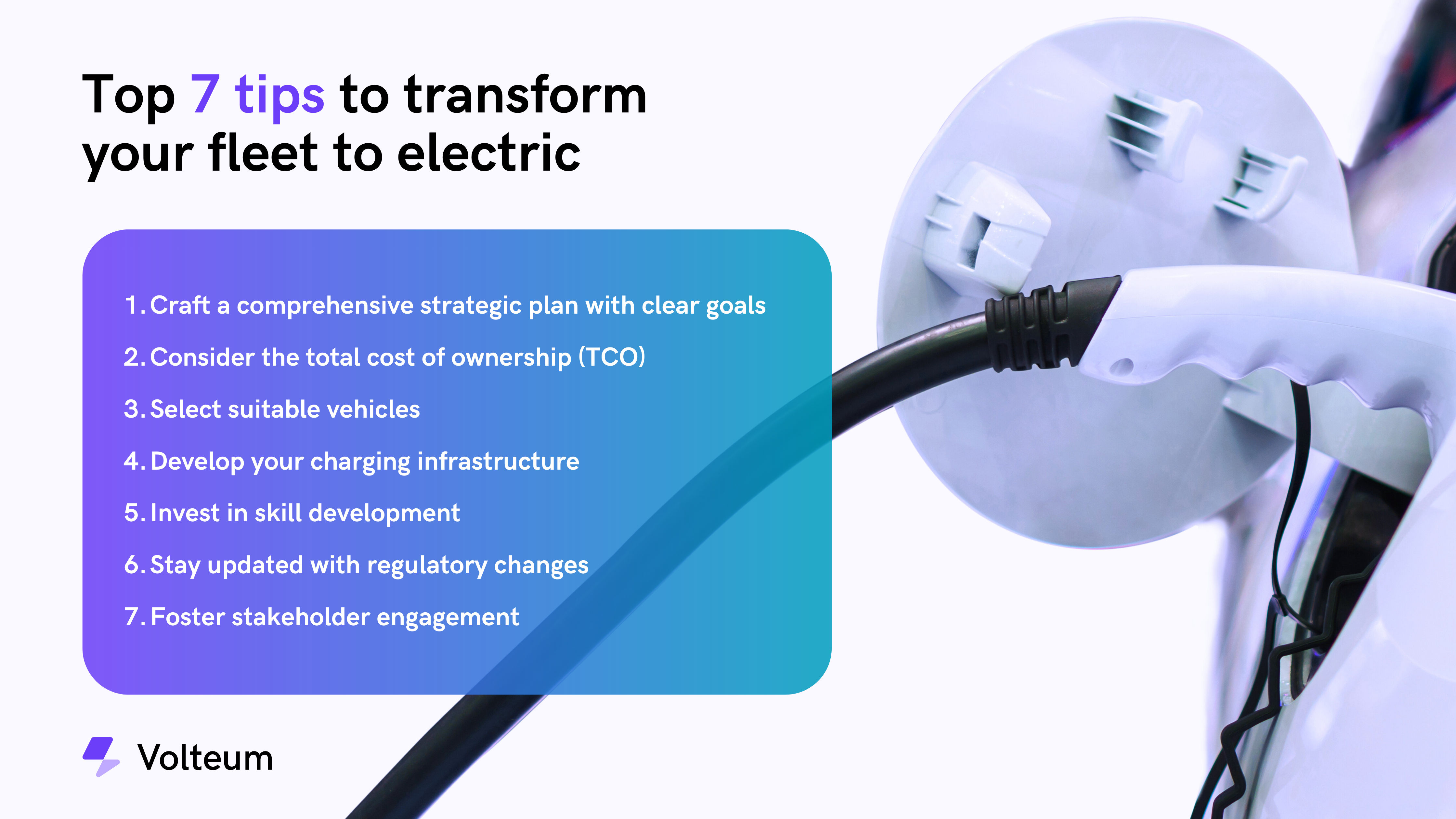Top 7 tips to transform your fleet to electric
Jul 10, 2023 · 4 min read · blog
Sustainability is not just a buzzword but a necessary transition for businesses worldwide. In this context, one aspect stands out: electrifying corporate fleets. This shift is integral to meeting ESG targets and forging ahead into a greener future.

For organisations with extensive fleets, the transition from combustion engines to electric vehicles (EVs) may seem intimidating. However, with a well-organised strategy, this shift can be rewarding. Let's explore the top 7 tips that can aid in the seamless electrification of your fleet.

Step 1: Craft a comprehensive strategic plan with clear goals

Embarking on this journey requires a robust strategic plan with well-defined, realistic objectives. Establish a timeframe within which you aim to reach a particular proportion of EVs in your fleet. This blueprint should not only align with your overarching sustainability objectives but also cater to your operational needs.

Step 2: Consider the total cost of ownership (TCO)

Transitioning to an electric fleet isn't just about the initial EV purchase costs. While EVs might have a steeper price tag than conventional vehicles initially, they often have lower running costs, considering factors like fueling and maintenance. Look beyond the sticker price and consider the complete lifecycle costs, including charging infrastructure, maintenance, residual values, and potential tax benefits.

Step 3: Select suitable vehicles

The EV market is diverse, with different models meeting different needs. Evaluate the specific requirements of your fleet, considering factors such as range, load capacity, and types of routes (urban, long-haul, etc.). Numerous electric cars and vans are available across Europe, particularly in the UK, Benelux, and Germany, to cater to a wide range of fleet needs.

Step 4: Develop your charging infrastructure

Creating an effective charging infrastructure is a crucial step in your electrification journey. On-site charging facilities, public charging networks, and home charging options for employees must be considered. You should also assess the capacity of your existing electrical infrastructure and plan for load management to prevent circuit overload.

Step 5: Invest in skill development

The operation and maintenance of EVs differ significantly from traditional vehicles. Providing drivers and fleet managers with comprehensive training on efficient driving techniques, proper charging protocols, and basic EV maintenance can ensure smoother operations and maximise the benefits of your electric fleet.

Step 6: Stay updated with regulatory changes

The landscape of EV and fleet regulations is dynamic, especially across different European regions. Keep abreast of these changes to leverage incentives, meet compliance requirements, and avoid potential penalties.

Step 7: Foster stakeholder engagement

The switch to an electric fleet is a significant change. Encourage open dialogue with all stakeholders, including drivers, fleet managers, executives, and shareholders. Discussing the advantages and addressing any concerns can foster a supportive environment for the successful implementation and operation of the electric fleet.



How Volteum helps the electrification journey

Navigating the transition to electric can appear daunting, but with the right partner, it doesn't need to be. At Volteum, we utilise cutting-edge software solutions to facilitate businesses throughout their electrification process. Our tailored solutions make strategic planning, charging infrastructure recommendation, and more, a breeze. Coupled with our industry experiences of working together with leading companies in the world, Volteum transforms the shift to an electric fleet into a straightforward, efficient, and sustainable process.

Moving forward

Transitioning your fleet to electric offers considerable advantages, both for your business and our planet. A well-crafted strategic plan, thorough understanding of costs, proper vehicle selection, adequate charging infrastructure, investment in training, staying updated with regulations, and stakeholder engagement all contribute to a smoother and more effective transition.

Partners like Volteum, with their advanced software solutions, can provide the necessary support to ensure your business is primed for the electrification journey.

This is just the beginning. In the upcoming blog posts, we will delve deeper into each aspect of fleet electrification, offering you a comprehensive guide to transitioning to an electric fleet. Join us as we explore the nuances of this exciting shift towards a more sustainable future. We're thrilled to accompany you on this journey.